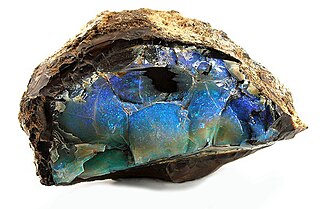Opal
silica mineral From Wikipedia, the free encyclopedia
Remove ads
The opal is a fairly white rock mineral. It is the birthstone for the month of October. Opals are made from tiny spheres of silica (another mineral) and lots of water. which means it has both silica (SiO₂) and water inside it. The amount of water in an opal can be between 3% to 21% of its weight, but most opals have around 6% to 10% water. Opal does not have a fixed crystal shape like some other stones. Because of this, it is called a mineraloid instead of a mineral. Minerals have a proper crystal structure, but opals don’t.[1]

Opal forms at low temperatures inside the earth. It can fill cracks or gaps (called fissures) in almost any type of rock. However, it is most often found with rocks like limonite, sandstone, rhyolite, marl, and basalt.[2]
Remove ads
Precious Opal
Precious opal is a type of opal that shows beautiful colors when you look at it from different angles. Even though it is a mineraloid, it still has a special kind of internal structure.[3]
If you look at a precious opal under a microscope, you will see that it is made up of tiny round balls of silica. These balls are called silica spheres, and each one is about 150 to 300 nanometers in size (that’s incredibly small around 0.0000059 to 0.0000118 inches). These tiny spheres are arranged very neatly in patterns called hexagonal or cubic close-packed lattices[4][5]
In the mid-1960s, a scientist named J. V. Sanders discovered that the bright colors inside precious opal happen because of the way light moves through this pattern of spheres. The spheres cause interference and diffraction of light which means they bend and spread the light, making it split into different colors.[6][7]
Remove ads
Common Opal
Common opal refers to varieties of opal that do not exhibit the characteristic play of color seen in precious opal. Several distinct types are recognized:[8]
- Milk Opal: Milky white, bluish, or greenish in appearance; in some cases, it may reach gemstone quality.
- Resin Opal: Honey-yellow in color with a resin-like luster.[9]
- Wood Opal: Formed through the replacement of the organic structure of wood with opal.
- Menilite: Typically brown or grey in color.[10]
- Hyalite: Colorless and transparent, resembling glass; also referred to as Muller’s glass.[11]
- Geyserite: Also called siliceous sinter; deposited around hot springs and geysers.[12]
- Diatomaceous Earth: Composed of the microscopic silica shells (tests) of diatoms[13]
Remove ads
History
In antiquity, opal was considered rare and highly valuable. In Europe, it was regarded as a prized gemstone among royalty. Prior to the discovery of extensive deposits in Australia during the 19th century, the only known significant source was Červenica, located beyond the Roman frontier in present-day Slovakia. Today, opal is recognized as the national gemstone of Australia.[14]
Related pages
References
Wikiwand - on
Seamless Wikipedia browsing. On steroids.
Remove ads
